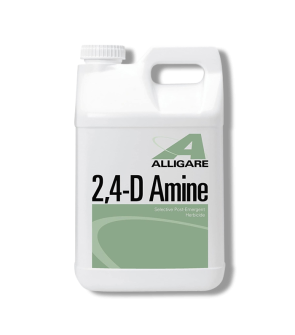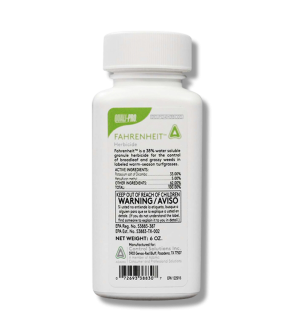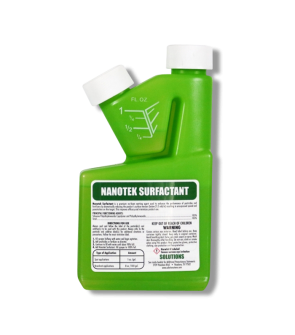Wild Garlic Control
Most Effective Products
Wild Garlic Control: How To Get Rid of Wild Garlic
Wild Garlic is a winter perennial plant that has been found popping up all across the southeast portion of the United States. Wild Garlic starts growing in the fall and is very similar to the Wild Onion plant, so much so that they are often lumped together as a problem on landscapes.
This weed is characterized by thin, green leaves that have a waxy texture and a strong garlic odor. Under the right conditions, wild garlic can overtake a landscape. Although it is called Wild Garlic, it is actually part of the onion family which includes onions and chives.
Wild garlic can be a challenge to get rid of from your lawn since mowing the plants often isn't enough to eliminate them as they will always grow back. This is why you should resort to using herbicides to control Wild Garlic if you want them gone.
If you notice wild garlic growing in your yard, the guide below can help. Our DIY treatment guide was developed by lawn care experts and will show exactly what to do to remove wild garlic from your lawn using our professional herbicide recommendations. Follow the step-by-step instructions below and you are guaranteed to eliminate wild garlic quickly and affordably.
Identification
Make sure that before you carry out treatment applications that you first properly identify the plant and confirm that it is wild garlic. Misidentification leads to using the wrong products and treatment methods, costing you time and money. The term ‘wild garlic’ can refer to many plants in the Allium genus, however, for the purpose of this article, we’ll talk about the weed that commonly grows throughout the US, Allium vineale.

- Wild garlic is a perennial, grass-like plant that grows from bulbs. They grow actively in the cooler weather of fall and spring and can grow up to 3 feet tall. When dug up, you can find small garlic bulbs with thin roots.
- In fall, bulbs sprout and emerge from the ground. By late winter to early spring, visible clumps resembling grass will have formed. The leaves of these plants are tube-like and hollow when cut open. By mid-spring, the plants will have grown in height. The leaves often grow in twists or curly shapes. By late spring and summer, aerial bulbs will form and burst with bulblets. These bulblets may or may not also be accompanied by purple or green flowers, and they will eventually sprout green “tails” before falling to the ground to grow new plants.
- To tell wild garlic from wild onion, check out the leaves. Wild garlic grows tubular leaves that are hollow inside, while wild onion grows flat, solid leaves. You can also dig up and check out the bulbs. A wild onion bulb is covered in a fibrous membrane, and a wild garlic bulb lacks this. If it’s late in the plant’s growing cycle, be aware that wild garlic develops an aerial bulb, which bursts into purple bulblets, while wild onions produce umbels of pink or white flowers that eventually become bulblets.
Use our description and image above to help you to identify wild garlic on your lawn. If you are not totally sure and need assistance with identification, contact us and we will properly ID the plant for you as well as give you the best product recommendations to control your weed.
Even though wild garlic is closely related to the cultivated garlic we buy in grocery stores, unless you’re a trained foraging professional, we advise you not to dig up wild garlic for consumption.
Inspection
After you have confirmation that you are dealing with wild garlic, proceed with an inspection to find out where the Wild Garlic growth is concentrated and what conditions may be helping the weed to thrive.

Where to Inspect
Wild garlic has a wide distribution throughout the United States. If you suspect weed activity in your lawn, look for patches of differently colored turf. These plants are often a different shade of green from your normal turf grass.
What To Look For
Wild garlic grows actively in cooler temperatures when most turf grasses become dormant. When the weather cools in fall, be on the lookout for taller patches of grass that have not lost their color to dormancy. In spring, look out for curly grass-like plants and early bulb formation. If bulblets have formed, control methods may only treat the existing plants and not any new plants that have yet to sprout.
Treatment
Wild garlic is a difficult weed to control and often a reoccurring issue on lawns where they have been established because there is no pre-emergent herbicide available that can control the weed. A post-emergent herbicide is your best option.
If you have a few wild garlic plants growing on your lawn, then manual pulling is manageable enough. Keep in mind that it’s easy for the plant leaves to break off from the bulb, and that other bulbs are often left in the ground to grow.
In lawns, mowing will also help, but not kill the plants entirely. With proper, consistent lawn care, weeds will eventually weaken and choke out.
For large infestations of wild garlic weeds, the best method of control is to apply a post-emergent herbicide that’s labeled to not injure your lawn’s native turf grass.
Step 1: Mix And Apply Herbicide

Determine how much product material to use by measuring the square footage of the treatment area. To do this, measure the length and width of the treatment area in feet then multiply them together (length X width = square footage). For acreage, take the square footage and divide it by one acre (square footage / 43,560 sq. ft. = acres).
In cool-season grasses, we recommend 2, 4-D Amine. The labeled application rate for this product is 3.16 pints of concentrate per 1 acre. For smaller applications, this breaks down to 1.1 fluid ounces of concentrate applied over 1,000 square feet.
In warm-season grasses, we recommend Fahrenheit Herbicide. For spot applications, mix 0.2 ounces of the product per 1 gallon of water to apply over 1,000 square feet. Keep in mind that when making applications over St. Augustinegrass, Bermudagrass, or Zoysiagrass, temporary stunting or chlorosis may occur.
For either of these products, we recommend you mix and apply your herbicide with a handheld pump sprayer. Because wild garlic leaves are waxy, we recommend you use a surfactant like Nanotek to enhance the effectiveness of your treatment. Nanotek is a non-herbicide product designed to improve the adhesion and penetration of pesticides onto treated surfaces. When using Nanotek, just add 1 fluid ounce per 1 gallon of solution.
Spot-treat any wild garlic plant you’ve found during your inspection. Use a fan or cone spray pattern to ensure the leaves are fully coated, and spray the weed to the point of wet but not runoff. Be sure to spray on calm days when temperatures are not too hot and when wind speeds are low to minimize drift.
Step 2: Reapply
When applied properly, affected weeds will yellow and begin to die. A follow-up application may be necessary if signs of recovery are observed, especially if the plant’s bulb is still alive. Reapplication intervals with 2, 4-D Amine range from 21 to 30 days. Reapplication intervals with Fahrenheit range from 4 to 6 weeks.
Applications are most effective when plants are actively growing before seed production. If the plants are close to producing seeds, you may need to mow the plant to prevent the weed from spreading. If you do mow, the bulb will survive and grow a new plant over the next year, providing another opportunity to apply chemical control.
Keep in mind that mechanical removal alone is not recommended, as it is easy to leave bulbs in the soil to grow new plants next season.
Prevention
Once the wild garlic has died out on your lawn, you will need to implement preventative measures to ensure the weed doesn't return. Here are some you can take:

- One of the best ways to control wild garlic after it’s been eliminated from your property is to mow it down if new plants start to sprout. When mowing lawns, simply mow regularly to the grass’s proper mowing height. Removing weeds before they can reproduce will stop them from spreading onto your property.
- We also recommend promoting the health of your turf to reduce the conducive conditions that allow weeds and disease to take hold. Reduce the shade cast on your lawn by trimming overgrown shrubbery and tree branches, rake away leaf litter and pick up any debris, and employ a proper watering schedule to provide the local grass with enough water to strengthen its roots, but not so much that will encourage weeds. Many grasses require 1 inch of water every week. Apply the water all at once in the morning so it has time to seep into the ground without evaporating in the sun.
Key Takeaways
What is Wild Garlic?
- Wild garlic is a winter perennial and can emerge onto a lawn out of nowhere in the late fall under the right conditions and is difficult to control.
- Wild Garlic is often confused with the similar wild onion but can be differentiated from the appearance of their leaves being thin and tube-like while wild onion leaves are wide and grass-like.
How To Get Rid of Wild Garlic
- Our top recommendation to treat wild garlic is 2,4-D Amine Selective Weed Killer with Nanotek Surfactant added to it. More than one application may be necessary as wild garlic is stubborn and persistent.
Preventing Wild Garlic Reinfestation
- To prevent a return of the weed, you will need to monitor your lawn and retreat in the fall and early spring for a few years due to wild garlic bulbs being able to stay dormant in the soil up to 6 years.















































































































































































































































































































































































































































































































































